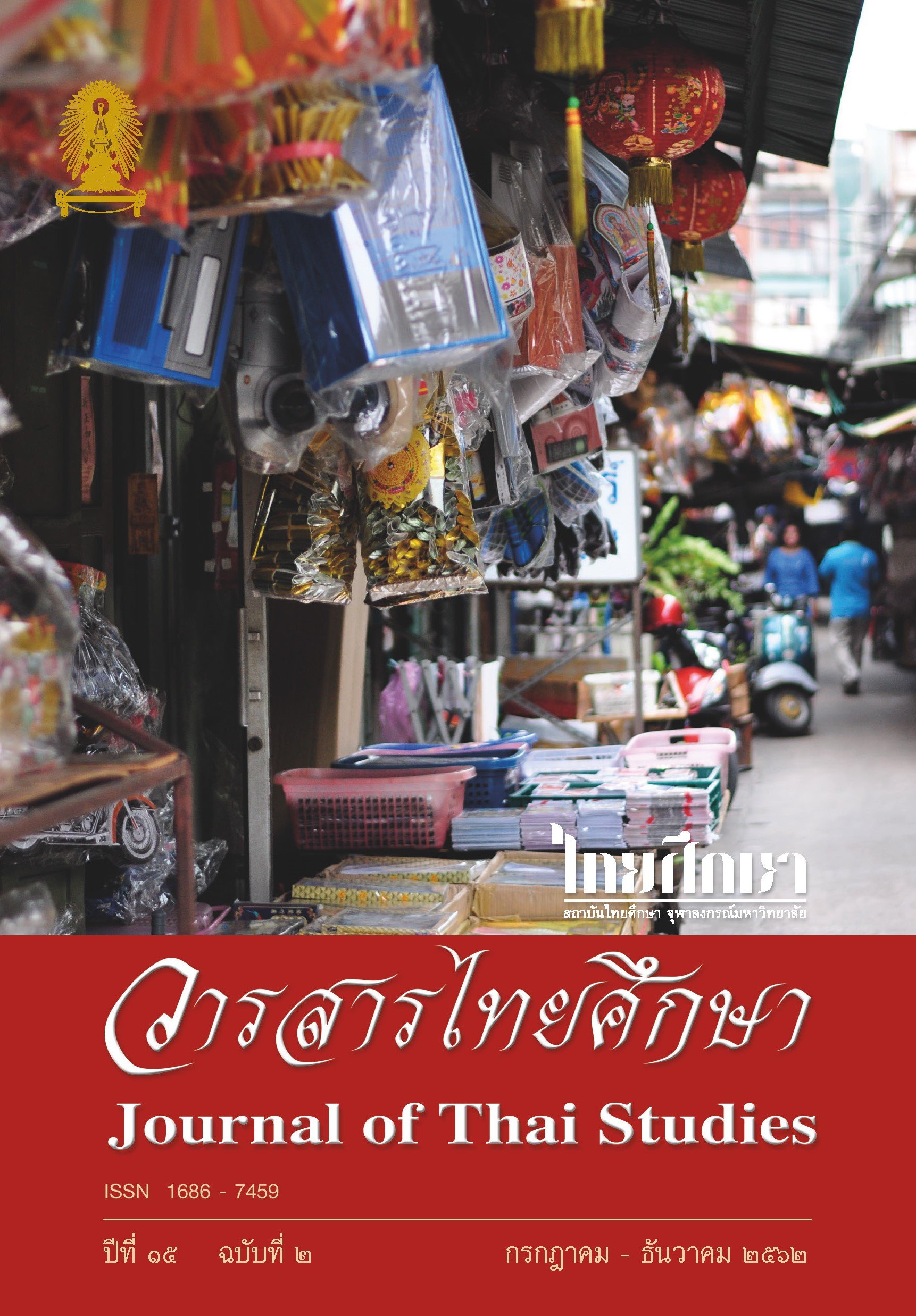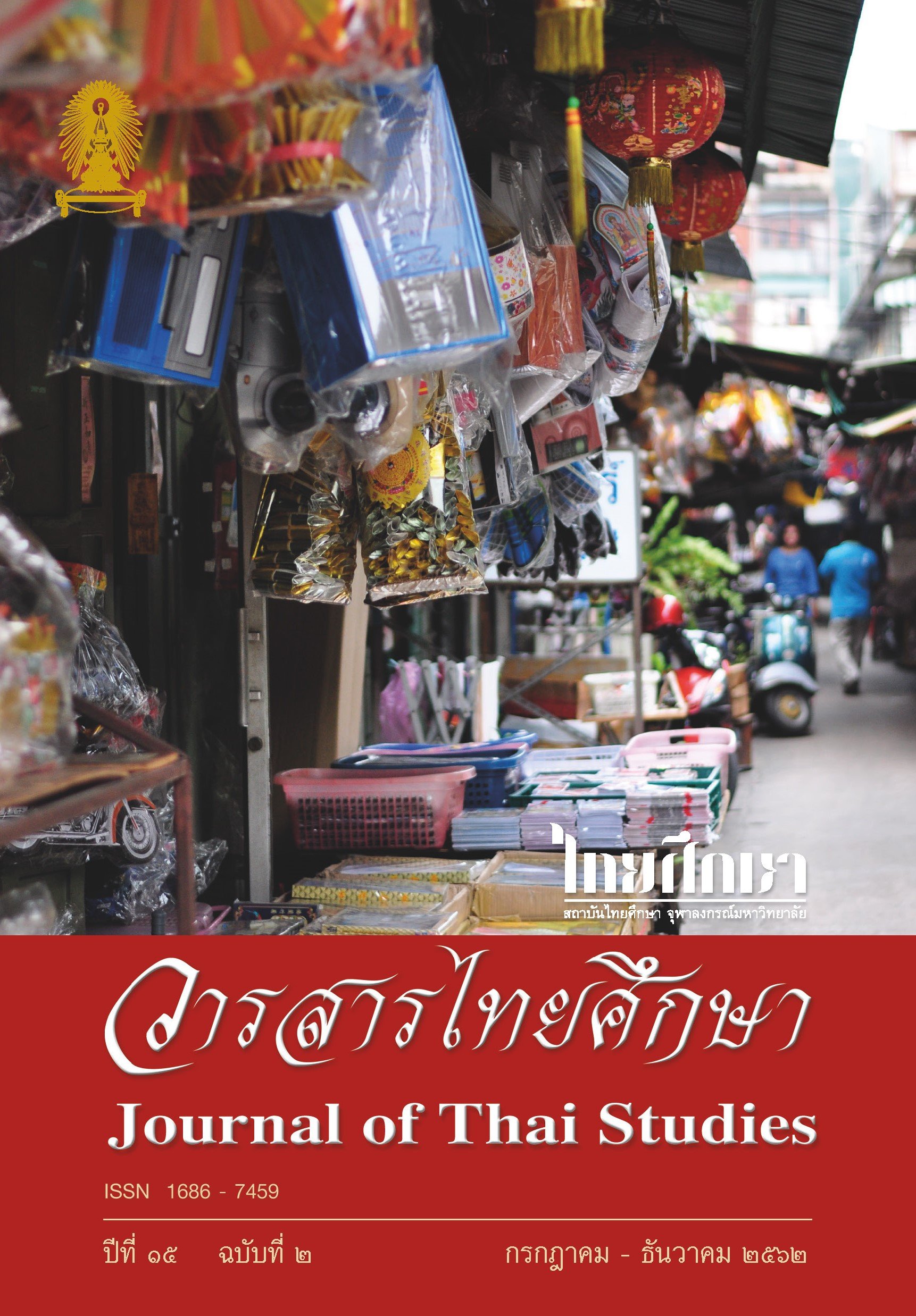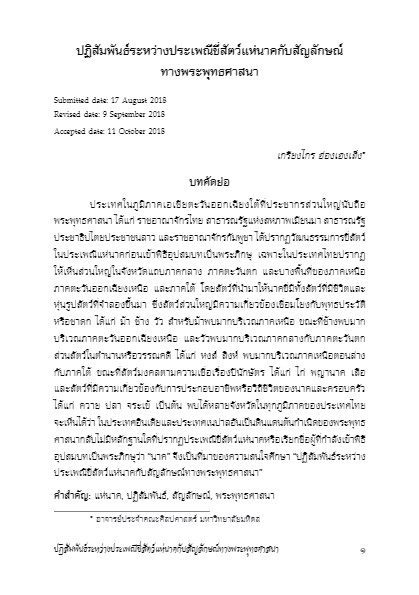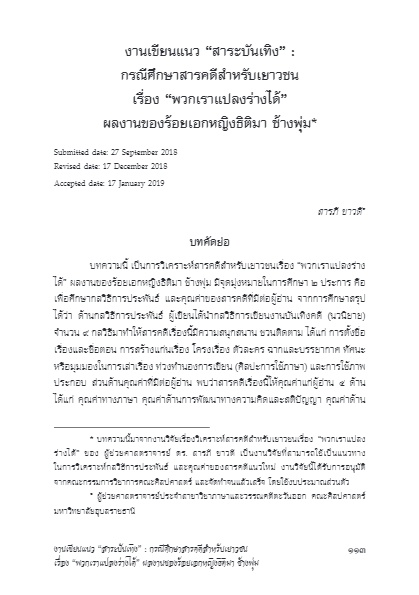วารสารไทยศึกษาปีที่ 15 ฉบับที่ 2

1) ปฏิสัมพันธ์ระหว่างประเพณีขี่สัตว์แห่นาคกับสัญลักษณ์ทางพระพุทธศาสนา /เกรียงไกร ฮ่องเฮงเส็ง
2) เจ้าพ่อทัพ: บทบาทของเจ้าพ่อทัพและประเพณีแห่เจ้าพ่อทัพที่มีต่อชุมชน /แคทรียา อังทองกำเนิด
3) การเดินทางของวิญญาณ: องค์ประกอบ และบทบาทของบทร้องพิธีกงเต๊กของชาวจีนแต้จิ๋วในสังคมไทย/ นรุตม์ คุปต์ธนโรจน์
4) ขนมเต่ากับพิธีกรรมเซ่นไหว้ในชุมชนตลาดน้อย กรุงเทพมหานครและชุมชนบางเหนียว จังหวัดภูเก็ต /สืบพงศ์ ช้างบุญชู
5) งานเขียนแนว “สาระบันเทิง” : กรณีศึกษาสารคดีสำหรับเยาวชน เรื่อง “พวกเราแปลงร่างได้” ผลงานของร้อยเอกหญิงธิติมา ช้างพุ่ม /ผู้ช่วยศาสตราจารย์ ดร.สารภี ขาวดี
6) “ของวิเศษ” ในวรรณกรรมไทยร่วมสมัยแนวเหนือจริง /จันทร์สุดา ไชยประเสริฐ และน้ำผึ้ง ปัทมะลางกุล
7) สตรีในเพลงรำวงมาตรฐานของท่านผู้หญิงละเอียด พิบูลสงคราม/ ธนสิน ชุตินธรานนท์
8) หนังสือพิมพ์ไทยกับกรอบการรายงานข่าวที่ส่งเสริมสิทธิมนุษยชนของผู้สูงวัย/ อลงกรณ์ ปริวุฒิพงศ์
ปฏิสัมพันธ์ระหว่างประเพณีขี่สัตว์แห่นาคกับสัญลักษณ์ทางพระพุทธศาสนา
ปฏิสัมพันธ์ระหว่างประเพณีขี่สัตว์แห่นาคกับสัญลักษณ์ทางพระพุทธศาสนา
เกรียงไกร ฮ่องเฮ็งเส็ง
บทคัดย่อ
ประเทศในภูมิภาคเอเชียตะวันออกเฉียงใต้ที่ประชากรส่วนใหญ่นับถือพระพุทธศาสนา ได้แก่ ราชอาณาจักรไทย สาธารณรัฐแห่งสหภาพเมียนมา สาธารณรัฐประชาธิปไตยประชาชนลาว และราชอาณาจักรกัมพูชา ได้ปรากฏวัฒนธรรมการขี่สัตว์ในประเพณีแห่นาคก่อนเข้าพิธีอุปสมบทเป็นพระภิกษุ เฉพาะในประเทศไทยปรากฏให้เห็นส่วนใหญ่ในจังหวัดแถบภาคกลาง ภาคตะวันตก และบางพื้นที่ของภาคเหนือ ภาคตะวันออกเฉียงเหนือ และภาคใต้ โดยสัตว์ที่นำมาให้นาคขี่มีทั้งสัตว์ที่มีชีวิตและหุ่นรูปสัตว์ที่จำลองขึ้นมา ซึ่งสัตว์ส่วนใหญ่มีความเกี่ยวข้องเชื่อมโยงกับพุทธประวัติหรือชาดก ได้แก่ ม้า ช้าง วัว สำหรับม้าพบมากบริเวณภาคเหนือ ขณะที่ช้างพบมากบริเวณภาคตะวันออกเฉียงเหนือ และวัวพบมากบริเวณภาคกลางกับภาคตะวันตก ส่วนสัตว์ในตำนานหรือวรรณคดี ได้แก่ หงส์ สิงห์ พบมากบริเวณภาคเหนือตอนล่างกับภาคใต้ ขณะที่สัตว์มงคลตามความเชื่อเรื่องปีนักกษัตร ได้แก่ ไก่ พญานาค เสือ และสัตว์ที่มีความเกี่ยวข้องกับการประกอบอาชีพหรือวิถีชีวิตของนาคและครอบครัว ได้แก่ ควาย ปลา จระเข้ เป็นต้น พบได้หลายจังหวัดในทุกภูมิภาคของประเทศไทย จะเห็นได้ว่า ในประเทศอินเดียและประเทศเนปาลอันเป็นดินแดนต้นกำเนิดของพระพุทธศาสนากลับไม่มีหลักฐานใดที่ปรากฏประเพณีขี่สัตว์แห่นาคหรือเรียกชื่อผู้ที่กำลังเข้าพิธีอุปสมบทเป็นพระภิกษุว่า “นาค” จึงเป็นที่มาของความสนใจศึกษา “ปฏิสัมพันธ์ระหว่างประเพณีขี่สัตว์แห่นาคกับสัญลักษณ์ทางพระพุทธศาสนา”
คำสำคัญ:แห่นาค ปฏิสัมพันธ์ สัญลักษณ์ ทางพระพุทธศาสนา
(ตีพิมพ์ใน วารสารไทยศึกษา ปีที่ 15 ฉบับที่ 2 (กรกฎาคม-ธันวาคม 2562) หน้า 1-29)
INTERACTION BETWEEN RIDING Animals IN ORDINATION CEREMONY Parades AND BUDDHIST SYMBOLISM
Kriangkrai Honghengseng
Abstract
Almost all countries in Southeast Asia where the people follow Buddhism, such as in the Kingdom of Thailand, the Republic of the Union of Myanmar, the Lao People's Democratic Republic and the Kingdom of Cambodia, have the culture of riding animals in ordination ceremony parades. In particular, this can be seen in Thailand covering many central, western and some northern and northeastern areas. The animals that are used include both living animals and simulated animals that are related to the legend of the Buddha consisting of horses, elephants and cows: horses in the northern region; elephants in northeastern; and cows both in the central and western areas. Animals in legends or literature, such as swan and lion, are found in the lower northern and southern areas. In addition, there are sacred animals in the Chinese zodiac belief, such as chickens, king of nagas and tigers. Also animals related to work or the way of life of the naga and his family, such as buffalo, fish and crocodiles, can be found in many areas of Thailand. It can be seen that in India and Nepal, the place of the origin of Buddhism, there is no tradition to call a man who will be the monk as a “naga” and there is also no animal riding culture in ordination parades. Therefore, it is interesting to study the interaction between animal riding in ordination ceremony parades and Buddhist symbolism.
Keywords: Ordination Ceremony Parade, Interaction, Symbolic, Buddhism
(Published in Journal of Thai Studies Volume 15 Number 2 (July-December 2019) Page 1-29)
บทความ / Full Text : 1_Kringkrai.pdf
เจ้าพ่อทัพ: บทบาทของเจ้าพ่อทัพและประเพณีแห่เจ้าพ่อทัพที่มีต่อชุมชน
เจ้าพ่อทัพ: บทบาทของเจ้าพ่อทัพและประเพณีแห่เจ้าพ่อทัพที่มีต่อชุมชน
แคทรียา อังทองกำเนิด
บทคัดย่อ
บทความวิจัยนี้มีวัตถุประสงค์เพื่อรวบรวมข้อมูลเกี่ยวกับเจ้าพ่อทัพ ศาลเจ้าพ่อทัพ ประเพณีแห่เจ้าพ่อทัพ และวิเคราะห์บทบาทของเจ้าพ่อทัพ และประเพณีแห่เจ้าพ่อทัพที่มีต่อชุมชน ผลการศึกษาพบว่าเจ้าพ่อทัพเป็นเทพเจ้าที่คนในพื้นที่เชื่อว่าคอยปกป้องคุ้มครองให้อยู่อย่างร่มเย็นเป็นสุข และในทุกปีจะมีการจัดประเพณีแห่เจ้าพ่อทัพเพื่อให้ผู้ที่เคารพศรัทธาเจ้าพ่อทัพได้เฝ้าชมบารมีและสักการบูชาเจ้าพ่อทัพเพื่อความเป็นสิริมงคล ในด้านบทบาทหน้าที่เจ้าพ่อทัพ และประเพณีแห่เจ้าพ่อทัพมีบทบาทต่อชุมชน 4 ประการคือ บทบาทด้านการเป็นที่พึ่งทางใจให้แก่คนในชุมชน บทบาทด้านการควบคุมพฤติกรรมของคนในชุมชน บทบาทด้านการสร้างความสมัครสมานสามัคคีในชุมชน และบทบาทด้านการให้ความเพลิดเพลินใจแก่คนในชุมชน
คำสำคัญ :เจ้าพ่อทัพ, บทบาท, เทพเจ้า, ประเพณีแห่เจ้าพ่อทัพ
(ตีพิมพ์ใน วารสารไทยศึกษา ปีที่ 15 ฉบับที่ 2 (กรกฎาคม-ธันวาคม 2562) หน้า 32-59)
Chao Pho Thap: The Roles of Chao Pho Thap and the Tradition of the Chao Pho Thap Procession for Local Communitie
Catthaleeya Aungthongkamnerd
Abstract
The objectives of this study are to: 1) gather information about Chao Pho Thap, Chao Pho Thap Shrines and the Chao Pho Thap Procession; 2) investigate the roles of Chao Pho Thap and the tradition of the Chao Pho Thap procession for local communities.
Based on the findings, Chao Pho Thap is highly regarded by local people for his power in providing protection and bringing them prosperous lives. The procession is held annually to honor and pay homage to Chao Pho Thap. In terms of their roles, Chao Pho Thap and the Chao Pho Thap Procession play important roles for local communities in four functions: 1) providing local people with spiritual support; 2) controlling the behavior of local people; 3) enhancing social harmony; and 4) providing local people with a range of entertainment activities.
Keywords: Chao Pho Thap, roles, God, Chao Pho Thap Procession
(Published in Journal of Thai Studies Volume 15 Number 2 (July-December 2019) Page 32-59)
บทความ / Full Text : 2_Cattaleeya.pdf
การเดินทางของวิญญาณ: องค์ประกอบ และบทบาทของ บทร้องพิธีกงเต๊กของชาวจีนแต้จิ๋วในสังคมไทย
การเดินทางของวิญญาณ: องค์ประกอบ และบทบาทของบทร้องพิธีกงเต๊กของชาวจีนแต้จิ๋วในสังคมไทย
นรุตม์ คุปต์ธนโรจน์
บทคัดย่อ
บทความนี้มุ่งศึกษาองค์ประกอบ และบทบาทของบทร้องพิธีกงเต๊กของชาวจีนแต้จิ๋วในสังคมไทย ผลการศึกษาพบว่า บทร้องดังกล่าวมีองค์ประกอบต่าง ๆ ได้แก่ การกล่าวถึงผู้นำทางดวงวิญญาณไปสู่โลกหลังความตายซึ่งจะมีบทบาทหน้าที่สำคัญคือ ชี้หรือนำทาง รวมทั้งช่วยขจัดอุปสรรคปัญหาระหว่างการเดินทางของวิญญาณ การระบุจุดหมายปลายทางของการเดินทางของวิญญาณ การกล่าวถึงเส้นทางเชื่อมสู่โลกหลังความตาย การระบุถึงพาหนะสู่โลกหลังความตาย และอุปสรรคขัดขวางระหว่างการเดินทาง ส่วนบทบาทของบทร้องคือช่วยเน้นย้ำความสัมพันธ์ของวิญญาณกับภูมิลำเนาเดิม ช่วยคลายความวิตกกังวลหรือความโศกเศร้าของลูกหลาน รวมทั้งเป็นคำสอนและคำอวยพรให้แก่ลูกหลานอีกด้วย
คำสำคัญ: บทร้องในพิธีกงเต๊กของชาวจีนแต้จิ๋ว, องค์ประกอบ, บทบาท
(ตีพิมพ์ใน วารสารไทยศึกษา ปีที่ 15 ฉบับที่ 2 (กรกฎาคม-ธันวาคม 2562) หน้า 61-81)
Journey of the Soul: the Components and Roles of the Hymns in Kongtek (Chaozhou Chinese Funerals) in Thai Society
Narut Kupthanaroj
Abstract
The objective of this article is to detail a study of the components and roles of the hymns in Kongtek (Chaozhou Chinese Funerals) in Thai Society. The results indicate that the hymns in Kongtek comprise various components including, the declaration of a leader responsible for a significant role in guiding a spirit to the afterlife and also removing obstacles during the journey of a spirit; the declaration of a spirit’s destination; the declaration of the path connecting to the afterlife; the declaration of the vehicle taking a spirit to the afterlife; and the obstacles during the journey. The roles of the hymns are to emphasize the relationship of spirits with their residences; to alleviate anxiety or grief of their families; and to be a doctrine and a blessing for their families.
Keywords: Hymns in Kongtek (Chaozhou Chinese Funerals), Component, Role
(Published in Journal of Thai Studies Volume 15 Number 2 (July-December 2019) Page 61-81)
บทความ / Full Text : 3_Narut (2).pdf
ขนมเต่ากับพิธีกรรมเซ่นไหว้ในชุมชนตลาดน้อย กรุงเทพมหานครและชุมชนบางเหนียว จังหวัดภูเก็ต
ขนมเต่ากับพิธีกรรมเซ่นไหว้ในชุมชนตลาดน้อย กรุงเทพมหานครและชุมชนบางเหนียว จังหวัดภูเก็ต
สืบพงศ์ ช้างบุญชู
บทคัดย่อ
ชุมชนตลาดน้อย กรุงเทพมหานครและชุมชนบางเหนียว จังหวัดภูเก็ตมีศาลเจ้าจีนฮกเกี้ยนอายุมากกว่าร้อยปีที่ผู้คนในชุมชนต่างให้ความเคารพและศรัทธา ในงานเทศกาลสำคัญประจำปีทั้งสองศาลเจ้าจะมีการเซ่นไหว้ขนมเต่าตามความเชื่อที่สืบต่อกันมา ชาวจีนฮกเกี้ยนเชื่อว่า เต่าเป็นสัตว์มงคล นอกจากเป็นสัญลักษณ์ของความมีอายุยืนยาว โชคลาภ ความร่ำรวยแล้ว เต่ายังช่วยป้องกันภัยอันตรายต่างๆ ได้ด้วย อย่างไรก็ตาม ขนมเต่าของทั้งสองชุมชนต่างมีเอกลักษณ์เฉพาะตัว และมีความแตกต่างจากขนมเต่าทั่วไปของชาวจีนฮกเกี้ยน ขนมเต่าของตลาดน้อยจะเป็นสีขาว ทำจากแป้งสาลี คล้ายซาลาเปา เซ่นไหว้เฉพาะเทศกาลหยวนเซียว ในขณะที่ขนมเต่าของชุมชนบางเหนียวจะเป็นสีแดง ทำจากแป้งข้าวเหนียว เซ่นไหว้เฉพาะประเพณีพ้อต่อในเทศกาลสารทจีน พิธีไหว้ขนมเต่าของทั้งสองชุมชนแสดงให้เห็นถึงการสืบสานและการกลืนกลายทางวัฒนธรรม ความเชื่อและพิธีกรรมต่างๆ ของพวกเขายังคงได้รับการถ่ายทอดจากคนรุ่นหนึ่งไปสู่คนอีกรุ่นหนึ่ง บางอย่างยังคงรักษารูปแบบดั้งเดิมไว้ได้อย่างเหนียวแน่น ขณะที่บางอย่างจำเป็นต้องปรับตัวให้สอดคล้องกับวัฒนธรรมท้องถิ่นและสภาพแวดล้อมทางสังคมที่เปลี่ยนแปลงไป
คำสำคัญ: ขนมเต่า ชุมชนตลาดน้อย ชุมชนบางเหนียว ฮกเกี้ยน
(ตีพิมพ์ใน วารสารไทยศึกษา ปีที่ 15 ฉบับที่ 2 (กรกฎาคม-ธันวาคม 2562) หน้า 84-111)
TORTOISE CAKE OFFERING RITUALS IN TALAD NOI, BANGKOK AND BANGNEAW, PHUKET
Seubpong Changboonchu
Abstract
Hokkien shrines that were built over 100 years ago in Talad Noi, Bangkok and Bangneaw, Phuket are highly revered, especially by the local people of these communities. Every year these two shrines prepare specially-made tortoise cakes as offerings during important festivals, as Hokkiens have long believed that a tortoise is an auspicious animal symbolizing longevity, fortune and wealth, while possessing power to protect people from harm. However, the tortoise cakes made by these two communities are significantly different from the more common Hokkien-style red tortoise cakes seen elsewhere. The Talad Noi cakes are white in color and made from wheat flour, similar to Chinese steamed buns. Talad Noi locals make these primarily as ritual offerings during the Lantern Festival. Bangneaw’s tortoise cakes, on the other hand, are red in color, made of glutinous rice flour, and are mainly prepared as ritual offerings during the Ghost Festival. Both tortoise cake offering rituals reflect the cultural assimilation and continuity in these two communities as their respective beliefs and customs are passed on from generation to generation. However, interestingly, while some of these beliefs and customs have been perfectly preserved in their original forms, others have assimilated to the changing local cultures and social environments.
Keywords: : Tortoise Cakes, Talad Noi, Bangneaw, Hokkien
(Published in Journal of Thai Studies Volume 15 Number 2 (July-December 2019) Page 84-111)
บทความ / Full Text : 4_Seubpong (1).pdf
งานเขียนแนว “สาระบันเทิง” : กรณีศึกษาสารคดีสำหรับเยาวชน เรื่อง “พวกเราแปลงร่างได้” ผลงานของร้อยเอกหญิงธิติมา ช้างพุ่ม
งานเขียนแนว “สาระบันเทิง” : กรณีศึกษาสารคดีสำหรับเยาวชน เรื่อง “พวกเราแปลงร่างได้” ผลงานของร้อยเอกหญิงธิติมา ช้างพุ่ม
สารภี ขาวดี
บทคัดย่อ
บทความนี้ เป็นการวิเคราะห์สารคดีสำหรับเยาวชนเรื่อง “พวกเราแปลงร่างได้” ผลงานของร้อยเอกหญิงธิติมา ช้างพุ่ม มีจุดมุ่งหมายในการศึกษา 2 ประการ คือเพื่อศึกษากลวิธีการประพันธ์ และคุณค่าของสารคดีที่มีต่อผู้อ่าน จากการศึกษาสรุปได้ว่า ด้านกลวิธีการประพันธ์ ผู้เขียนได้นำกลวิธีการเขียนงานบันเทิงคดี (นวนิยาย) จำนวน 9 กลวิธีมาทำให้สารคดีเรื่องนี้มีความสนุกสนาน ชวนติดตาม ได้แก่ การตั้งชื่อเรื่องและชื่อตอน การสร้างแก่นเรื่อง โครงเรื่อง ตัวละคร ฉากและบรรยากาศ ทัศนะหรือมุมมองในการเล่าเรื่อง ท่วงทำนองการเขียน (ศิลปะการใช้ภาษา) และการใช้ภาพประกอบ ส่วนด้านคุณค่าที่มีต่อผู้อ่าน พบว่าสารคดีเรื่องนี้ให้คุณค่าแก่ผู้อ่าน 4 ด้าน ได้แก่ คุณค่าทางภาษา คุณค่าด้านการพัฒนาทางความคิดและสติปัญญา คุณค่าด้านพัฒนาการทางบุคลิกภาพ และคุณค่าด้านพัฒนาการทางสังคม อาจกล่าวได้ว่า “พวกเราแปลงร่างได้” คือ สารคดีแนวใหม่ หรือ แนว “edutainment” ที่มีการผสมผสานระหว่างสาระความรู้ (education) และความบันเทิง (entertainment) สามารถตอบสนองความต้องการของผู้อ่านที่มุ่งเสพความสนุกสนานเพลิดเพลิน ขณะเดียวกันก็ได้รับความรู้จากการอ่านอันเป็นวัตถุประสงค์หลัก
คำสำคัญ : สาระบันเทิง สารคดีสำหรับเยาวชน
(ตีพิมพ์ใน วารสารไทยศึกษา ปีที่ 15 ฉบับที่ 2 (กรกฎาคม-ธันวาคม 2562) หน้า 113-163)
Edutainment as a Writing Genre: A Case Study of the Young-Adult Documentary Fiction “We Can Transform” by Captain Thitima Changphoom
Sarapee Kaowdee
Abstract
This article aims to detail a study of the young-adult documentary book entitled “We Can Transform”, which was written by Captain Thitima Changpoom. The purpose of this study is two-fold: to investigate the author’s writing techniques and to explore the book’s values.
The findings reveal that the author adopted nine literary writing techniques to seize the reader’s attention. Such techniques include the name of the title and use of plots, themes, characters, setting and tone, writing style (language arts) and illustration. With respect to the book’s values, it was found that this documentary book offers significant value to the reader in four aspects: language value, and values in enhancing the reader’s intellect, personality and social development. It might be concluded that “We Can Tranform” is a new type of documentary fiction or edutainment literary genre that manages to blend knowledge and entertainment and meet the needs of those who seek the pleasure of reading while simultaneously gaining the knowledge that the author aims to provide.
Keywords : Edutainment Young-adult Documentary Fiction
(Published in Journal of Thai Studies Volume 15 Number 2 (July-December 2019) Page 113-163)
บทความ / Full Text: 5_Sarapee.pdf
“ของวิเศษ” ในวรรณกรรมไทยร่วมสมัยแนวเหนือจริง
“ของวิเศษ” ในวรรณกรรมไทยร่วมสมัยแนวเหนือจริง
จันทร์สุดา ไชยประเสริฐ
น้ำผึ้ง ปัทมะลางกุล
บทคัดย่อ
บทความนี้มุ่งศึกษาการปรากฏของ “ของวิเศษ” ในวรรณกรรมไทยร่วมสมัยแนวเหนือจริง จำนวน 6 เรื่อง ได้แก่ แก้วราหู กุหลาบรัตติกาล เพชรอัคนี สร้อยแสงจันทร์ รากบุญ และทองพญามาร ผลการศึกษาพบว่า วรรณกรรมไทยร่วมสมัยแนวเหนือจริงนำเสนอของวิเศษที่มีลักษณะทั้งตามจารีตที่ปรากฏในวรรณคดีและของวิเศษที่มีลักษณะสมัยใหม่ โดยของวิเศษต่างมีคุณสมบัติสำคัญ คือ สามารถบันดาลให้ผู้คน
สมปรารถนาและให้ความคุ้มครองผู้เป็นเจ้าของ ของวิเศษในวรรณกรรมไทยร่วมสมัยแนวเหนือจริงมีทั้งที่มาจากวรรณคดีและจากการสร้างลักษณะของของวิเศษขึ้นใหม่ให้สัมพันธ์กับสังคมร่วมสมัย ผู้สร้างของวิเศษในวรรณกรรมไทยร่วมสมัยแนวเหนือจริงมีทั้งตัวละครที่เป็นเทพเจ้าและมนุษย์ ส่วนผู้ครอบครองของวิเศษมีการปรับเปลี่ยนสถานภาพไปจากวรรณคดีที่เป็นกษัตริย์หรือโอรสของกษัตริย์มาเป็นสามัญชนที่มีปัญหาชีวิตและความโลภ ทำให้บทบาทของของวิเศษปรับเปลี่ยนจากการสนับสนุนแนวคิดเรื่องบุญญาบารมีมาเป็นการนำเสนอแนวคิดเรื่องกิเลส อันสะท้อนได้จากการกระทำของตัวละครที่พยายามค้นหาและแย่งชิงของวิเศษมาครอบครองเพื่อช่วยแก้ไขปัญหาและทำให้ตนสมปรารถนา การปรากฏของของวิเศษในวรรณกรรมไทยร่วมสมัยแนวเหนือจริงยังสะท้อนภาพสังคมไทยร่วมสมัยซึ่งเป็นสังคมทุนนิยมอย่างชัดเจน
คำสำคัญ : ของวิเศษ, วรรณกรรมไทยร่วมสมัยแนวเหนือจริง
(ตีพิมพ์ใน วารสารไทยศึกษา ปีที่ 15 ฉบับที่ 2 (กรกฎาคม-ธันวาคม 2562) หน้า 165-191)
“Magical Objects” in Contemporary Thai Paranormal Literary Works
Chansuda Chaiprasert
Namphueng Padamalangula
Abstract
This article aims to detail a study of “Magical Objects” in six contemporary Thai paranormal literary works: Kaew Rahu, Kularp Rattikal, Petch Aknee, Sroisaengjan, Rak Bun, and Tongpayamarn. The research found that in these surreal pieces of contemporary Thai literature, the magic of traditional characters of both ancient and modern literature is represented. The key features of the magic were the ability to fulfill one’s desire and to give protection to the owner. While the representation of this magic was derived from literature, the creation of new features of the magic is related to contemporary society. The creators of the magic in contemporary Thai literature include gods and humans; while the owner of the magic in contemporary Thai literature changed from ancient literature, in which the owner was a king or royal prince of the king, to become ordinary people who had life problems and were full of greed. This has led to changing the role of the magic from supporting the concept of ethical virtue to representing the concept of human greed. This is a reflection of a character’s action that tried to use the magic in order to solve problems and fulfill one’s desire. In addition, magic in contemporary literature clearly reflects the modern capitalistic Thai society.
Keyword: Magical Object, Contemporary Thai Paranormal Literary Works
(Published in Journal of Thai Studies Volume 15 Number 2 (July-December 2019) Page 161-191)
บทความ / Full Text : 6_Chansuda (1).pdf
สตรีในเพลงรำวงมาตรฐานของท่านผู้หญิงละเอียด พิบูลสงคราม
สตรีในเพลงรำวงมาตรฐานของท่านผู้หญิงละเอียด พิบูลสงคราม
ธนสิน ชุตินธรานนท์
บทคัดย่อ
บทความนี้มุ่งวิเคราะห์คุณสมบัติของสตรีที่ได้รับการนำเสนอในเพลงรำวงมาตรฐานทั้ง 6 เพลงของท่านผู้หญิงละเอียด พิบูลสงคราม
ผลการศึกษาพบว่าเพลงดังกล่าวนำเสนอคุณสมบัติของสตรีไทยที่พึงปรารถนาท่ามกลางสมัยสงครามโลกครั้งที่ 2 รวมทั้งสิ้น 3 ประการ ได้แก่ 1) สตรีไทยพึงงดงามตามขนบ กล่าวคือ ในบทร้องเพลงรำวงมาตรฐานปรากฏชัดเจนถึงการชมความงามของสตรีว่างามราวกับดวงเดือนหรือดวงจันทร์ ซึ่งเป็นการสืบทอดขนบที่ปรากฏชัดเจนจากวรรณคดีไทย นอกจากนี้ยังปรากฏการชมคุณสมบัติด้านกิริยา และวาจาของสตรีอีกด้วย 2)สตรีไทยพึงเป็นดอกไม้ของชาติ กล่าวคือ ท่ามกลางภาวะสงครามที่ประเทศต้องการกำลังพลนั้น สตรีไทยพึงมีหน้าที่เฉกเช่นบุรุษ ซึ่งต้องมีความกล้าหาญ และทำหน้าที่ปกป้องขัณฑสีมา สอดคล้องกับนโยบายของรัฐบาลในสมัยนั้นที่มีการจัดตั้งโรงเรียนสอนทหารหญิงขึ้นครั้งแรกของประเทศ 3) สตรีไทยพึงรักบุรุษที่รักชาติ กล่าวคือ แม้ว่าผู้แต่งจะชื่นชมคุณสมบัติความงามทางกายภาพของสตรี แต่ในส่วนของบุรุษนั้น ผู้แต่งเลือกชื่นชมเฉพาะคุณสมบัติด้านความจงรักภักดีต่อชาติ อีกทั้งปรากฏว่าสตรีควรเลือกรักบุรุษที่มีลักษณะดังกล่าวนี้เป็นสำคัญ อย่างไรก็ดีการใช้เพลงในฐานะสื่อบันเทิงคดีทางวัฒนธรรมเพื่อประโยชน์ทางการเมืองนั้น ปรากฏชัดเจนผ่านทำเนียบภาษาที่ผู้ประพันธ์ใช้ในบทร้อง กล่าวคือ ผู้แต่งเจตนาใช้ทำเนียบภาษาด้านการเมืองการปกครองในบทร้องเพลงทั้ง 6 เพลง กล่าวได้ว่าท่านผู้หญิงละเอียด พิบูลสงคราม สามารถใช้เพลงซึ่งเป็นสื่อบันเทิงคดีเพื่อชี้นำสังคมได้อย่างแยบคาย
คำสำคัญ: การสื่อสาร, ท่านผู้หญิงละเอียด พิบูลสงคราม, เพลงรำวงมาตรฐาน, สตรีศึกษา, สื่อบันเทิงคดี
(ตีพิมพ์ใน วารสารไทยศึกษา ปีที่ 15 ฉบับที่ 2 (กรกฎาคม-ธันวาคม 2562) หน้า 193-218)
Women in Thanphuying La-iad Phibunsongkhram’s Rumwong Songs
Thanasin Chutintaranond
Abstract
This article aims to detail an analysis of women’s qualifications in the lyrics of six rumwong songs’ that were composed by Thanphuying La-iad Phibunsongkhram. The results found that these songs represent three desired qualifications of Thai women during the World War II era. 1) Thai women should carry on Thai conventional of beauty. The lyrics disclose clear metaphorical comparisons from Thai literature convention that typically compares the beauty of women to the beauty of the moon. Moreover, good manners and good rhetoric are needed. 2) Thai women should be a flower of the nation. In accordance with the war situation, Thailand could not deny women power since everyone in the nation, whether man or woman, had a vital duty to protect the nation. This was related to the government’s policy to establish a female military school. 3) Thai women should love only patriotic men. While the lyrics admired the beauty of women, for men, faithfulness and patriotism to the nation were required. These qualifications are important and significant for women to consider before they chose their lover. Nevertheless, the composer intended to use the six rumwong songs as cultural entertainment to lead the society by harmoniously transmitting some political messages through the lyrics.
Keywords: Communication, Thanphuying La-iad Phibunsongkhram, rumwong songs, women studies, entertainment media
(Published in Journal of Thai Studies Volume 15 Number 2 (July-December 2019) Page 193-218)
บทความ / Full Text : 7_Thanasin (2).pdf
หนังสือพิมพ์ไทยกับกรอบการรายงานข่าวที่ส่งเสริมสิทธิมนุษยชนของผู้สูงวัย
หนังสือพิมพ์ไทยกับกรอบการรายงานข่าวที่ส่งเสริมสิทธิมนุษยชนของผู้สูงวัย
อลงกรณ์ ปริวุฒิพงศ์
บทคัดย่อ
การวิจัยครั้งนี้มีวัตถุประสงค์เพื่อวิเคราะห์การนำเสนอข่าวเกี่ยวกับผู้สูงวัยในหนังสือพิมพ์กระแสหลักและสำนักข่าวออนไลน์ 12 ฉบับระหว่างเดือนกรกฏาคม ถึง ธันวาคม พศ.2561 โดยศึกษาการวางกรอบข่าว (News Framing) และภาพตัวแทน (Media Representation) ที่มีนัยยะต่อการส่งเสริมสิทธิมนุษยชนของผู้สูงวัย ผลการวิจัยพบว่าหนังสือพิมพ์ไทยทำหน้าที่สื่อกลางที่สนับสนุนสิทธิมนุษยชนของผู้สูงวัยอย่างรอบคอบ แม้จะมีการรายงานข่าวที่เป็นการสร้างภาพลบต่อกลุ่มผู้สูงวัยในข่าวทั่วไปอยู่บ้าง แต่พบว่ามีการรายงานข่าวเฉพาะที่เสริมแรง/ตอกย้ำ หรือ ส่งเสริมประเด็นสิทธิมนุษยชน โดยมีจุดเน้นที่มิติทางสังคมและทางเศรษฐกิจ มากกว่ามิติทางการเมือง ส่วนรูปแบบการนำเสนอข่าวและภาพของผู้สูงวัยจะมีลักษณะตั้งรับต่อนโยบายของรัฐในขณะที่ข่าวที่ใช้แหล่งข่าวภาคเอกชนมักจะสร้างภาพผู้สูงวัย ในฐานะ “ลูกค้า” หรือ “ผู้รับบริการ” ขณะที่ประเทศไทยกำลังก้าวสู่สังคมสูงวัยเต็มรูปแบบ สื่อจึงถูกคาดหวังว่าจะสามารถนำเสนอข่าวผู้สูงวัยที่มีบูรณาการกับภาคส่วนอื่นในสังคม เพื่อสร้างความเข้าใจในวงกว้าง ด้วยเหตุนี้จึงจำเป็นที่สื่อจะหาวิธีการรายงานที่ลดอคติเรื่องวัยเพื่อหวังว่าให้เกิดการเปลี่ยนแปลงในการวางกรอบข่าวเรื่องสิทธิมนุษยชนของผู้สูงวัยในแนวรุกและแบบก้าวหน้ามากขึ้น
คำสำคัญ: ผู้สูงวัย, สังคมผู้สูงวัย, หนังสือพิมพ์, สิทธิมนุษยชน
(ตีพิมพ์ใน วารสารไทยศึกษา ปีที่ 15 ฉบับที่ 2 (กรกฎาคม-ธันวาคม 2562) หน้า 219-253)
Thai Newspapers and news framing in reports related to promotion of human rights of the elderly.
Alongkorn Parivudhiphongs
Abstract
This study examines the presentation of news about the elderly in mainstream Thai newspapers and by online news agencies between July and December 2018, covering 12 news sources in total. This study employs concepts of news framing and media representation in relation to the promotion of human rights of the elderly in Thailand. The research suggests that most Thai newspapers act as vigilant mediators that carefully support the human rights of the elderly. Although a few general news reports create negative images of the elderly, other, more specific news reports tend to emphasize or promote human rights of the elderly, with a focus on social and economic dimensions rather than political rights. The pattern of news framing and media representation of the elderly shows that most news reports are reactive to government policy related to the elderly rather than proactive. The elderly are also often portrayed as potential customers and clients of the private sector. As the country is moving towards an aging society, one might expect that, over time, reports will increasingly integrate issues related to the elderly with other social sectors so as to create broader understanding. Accordingly, it is necessary for the media to find a balance in coverage of the elderly in order to reduce prejudice based on age whilst framing and representing the elderly in a more proactive and progressive fashion.
Keywords: Elderly, Aging Society, Newspapers, Human Rights
(Published in Journal of Thai Studies Volume 15 Number 2 (July-December 2019) Page 1-29)
บทความ / Full Text : 8_Alongkorn (1).pdf



.pdf.jpg?alt=media&token=3ea633ba-90b6-491c-a51f-d1904e39b1d7)
.pdf.jpg?alt=media&token=657d8ab7-2ab2-4e8f-81ee-cb4e332f7fbe)

.pdf.jpg?alt=media&token=dd3a0ea7-2914-4ccc-a2cf-f9ea85318741)
.pdf.jpg?alt=media&token=795ccf9b-d839-453a-bbff-7d113e805263)
.pdf.jpg?alt=media&token=5a762064-155d-4d4f-98b8-35c29df6fcd3)
